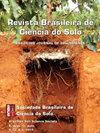Hydropedological digital mapping: machine learning applied to spectral VIS-IR and radiometric data dimensionality reduction
IF 2
4区 农林科学
Q3 SOIL SCIENCE
引用次数: 0
Abstract
ABSTRACT Pedosphere-hydrosphere interface accounts for the association between soil hydrology and landscape, represented by topographic and Remote Sensing data support and integration. This study aimed to analyze different statistical radiometric and spectral data selection methods and dimensionality reduce environment-related data to support the classification of soil physical-hydric properties, such as soil basic infiltration rate (bir) and saturated hydraulic conductivity (Ksat); as well as to act in data mining processes applied to hydropedological properties digital mapping. Accordingly, research integrated information from Visible to Infrared (VIS-IR) spectral indices and Sentinel’s 2A mission Multispectral Instrument (MSI) sensor bands, terrain numerical modeling and aerogeophysics set to model soil-water content in two soil layers (0.00-0.20 m and 0.20-0.40 m). Pre-processed data were subjected to statistical analysis (multivariate and hypothesis tests); subsequently, the methods were applied (variation inflation factor - VIF, Stepwise Akaike information criterion – Stepwise AIC, and recursive feature elimination - RFE) to mine covariates used for Random Forest modeling. Based on the results, there were distinctions and singularities in spectral and radiometric data selection for each adopted method; the importance degree, and contribution of each one to soil physical-hydric properties have varied. According to the applied statistical metrics and decision-making criteria (highest R 2 and lowest RMSE / MAE), the chosen methods were RFE (0.00-0.20 m layers) and Stepwise AIC (0.20-0.40 m layers) - both concerned with the assessed variables (bir and Ksat). This approach captured the importance of environmental variables and highlighted their potential use in hydropedological digital mapping at Guapi-Macacu watershed.水文数字制图:应用于光谱VIS-IR和辐射数据降维的机器学习
土壤圈-水圈界面是土壤水文与景观之间的联系,以地形和遥感数据的支持与整合为代表。本研究旨在分析不同的统计辐射和光谱数据选择方法,并对环境相关数据进行降维,以支持土壤基本入渗率(bir)和饱和导水率(Ksat)等土壤物理-水文特性的分类;以及在数据挖掘过程中应用于水文特性数字制图。基于此,研究综合了可见光-红外(VIS-IR)光谱指数和Sentinel’s 2A任务多光谱仪器(MSI)传感器波段、地形数值模拟和航空地球物理数据,分别模拟了0.000 ~ 0.20 m和0.20 ~ 0.40 m两个土层的土壤含水量,并对预处理数据进行了统计分析(多元检验和假设检验);随后,应用变异膨胀因子(VIF)、逐步Akaike信息准则(Stepwise AIC)和递归特征消除(RFE)方法挖掘随机森林模型中使用的协变量。结果表明,每种方法在光谱和辐射数据的选择上均存在差异和奇异性;它们对土壤物理-水性质的重要程度和贡献各不相同。根据应用的统计指标和决策标准(最高r2和最低RMSE / MAE),选择的方法是RFE (0.00-0.20 m层)和Stepwise AIC (0.20-0.40 m层),两者都与评估变量(bir和Ksat)有关。该方法抓住了环境变量的重要性,并突出了它们在瓜皮-澳门流域水文水文数字制图中的潜在应用。
本文章由计算机程序翻译,如有差异,请以英文原文为准。
求助全文
约1分钟内获得全文
求助全文
来源期刊

Revista Brasileira De Ciencia Do Solo
农林科学-土壤科学
CiteScore
3.00
自引率
11.80%
发文量
32
审稿时长
9-24 weeks
期刊介绍:
The Revista Brasileira de Ciência do Solo is a scientific journal published by the Brazilian Society for Soil Science (SBCS), founded in 1947, and is responsible for the propagation of original and inedited technical-scientific work of interest for Soil Science.
Contributions must not have been previously published or submit to other periodicals, with the only exception of articles presented in summarized form at professional meetings. Literature reviews are accepted when solicited by the Editorial Board.
 求助内容:
求助内容: 应助结果提醒方式:
应助结果提醒方式:


